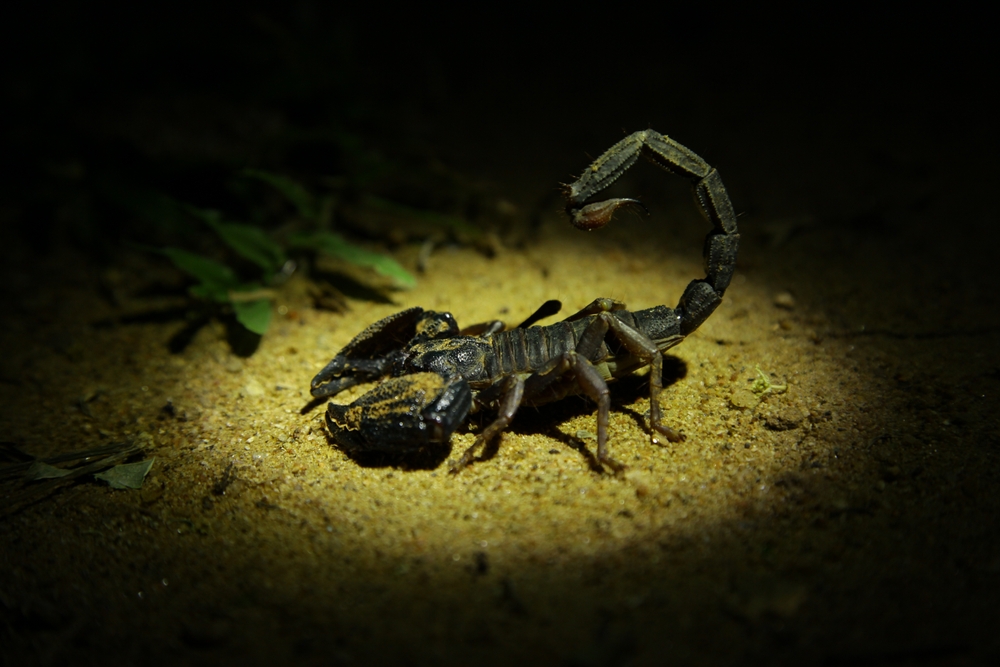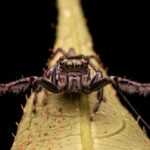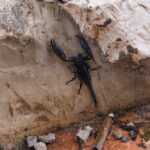Comprehensive Guide to the Types of Scorpions
Scorpions come in over 2,500 TYPES OF SCORPIONS, each with unique traits and habitats. This guide will explore common scorpion species in the U.S. and notable ones worldwide, helping you understand their distinctions and manage any risks they pose.
- Scorpions are ancient arthropods with over 2,500 species, primarily found in subtropical regions, and most pose little threat to humans.
- The Arizona bark scorpion is the only life-threatening species in the U.S., distinguished by its venomous sting and ability to glow under UV light.
- Effective scorpion control involves preventive measures to deter infestations and chemical methods for managing severe populations when necessary.
Overview of Scorpions
Scorpions, with their crablike appearance, are notable for their pair of pincers, four pairs of legs, and segmented tail ending in a stinger. Their anatomy is divided into two main parts: the cephalothorax and the abdomen, the latter further split into the mesosoma and metasoma. These terrestrial arthropods have been around for about 435 million years, marking their presence as one of the oldest creatures on Earth.
These resilient creatures are found on every continent except Antarctica, thriving in various habitats, including deserts, mountains, and caves. With over 2,500 species classified into 22 families, scorpions display a remarkable diversity. In the U.S. alone, around 70 species exist, demonstrating their adaptability and survival skills.
Their highest diversity is seen in subtropical regions, where they have evolved to occupy a wide range of ecological niches. Despite their fearsome reputation, most scorpions are not a threat to humans. Understanding their characteristics and behaviors is essential for appreciating these fascinating creatures and managing any potential risks they pose.
Common Scorpion Species in the U.S.
In North America, approximately 70 scorpion species can be found, with about 25 considered potentially lethal to humans. Among these, the Arizona bark scorpion, desert hairy scorpion, and stripe-tailed scorpion are the most commonly encountered.
The Arizona bark scorpion, found in Arizona, southeastern California, southwestern New Mexico, and parts of Mexico, is notorious for its venomous sting. It is the only dangerous scorpion species in California, often hiding under tree bark, palm trees, rocky cliffs, and bark scorpions.
The desert hairy scorpion, the largest North American scorpion, can grow up to 5.5 inches in length but has a sting comparable to a bee sting for most people. These scorpions thrive in diverse habitats, from dry deserts to rocky terrains.
Their adaptability allows them to occupy various ecological niches, making them a common sight in the southwestern United States. Understanding their behavior and habitats is crucial for avoiding encounters and managing infestations.
Arizona Bark Scorpion
The Arizona bark scorpion, a small but perilous creature, can reach up to 2-3 inches in length. One of its fascinating traits is its ability to glow green under ultraviolet light, a feature that makes it easy to spot during nighttime inspections. Their remarkable climbing skills enable them to inhabit elevated locations, such as trees and walls, making them a common indoor invader.
These nocturnal hunters prefer cool, dark areas during the day, emerging at night to hunt a variety of insects, spiders, and even other scorpions. Their diet and hunting techniques are adapted to the harsh desert environment, ensuring their survival and proliferation.
However, the Arizona bark scorpion is not just another desert dweller. It is the only life-threatening scorpion species in Arizona, capable of causing severe symptoms, especially in children and the elderly. Their stings can lead to intense pain, swelling, and in some cases, systemic reactions that require immediate medical attention.
Desert Hairy Scorpion
The Desert Hairy Scorpion, or Hadrurus arizonensis, is the largest scorpion species in North America, with lengths reaching up to six inches. This imposing size, coupled with its hairy appearance, makes it a distinctive and somewhat intimidating presence in the deserts of the Southwestern United States and Northern Mexico.
Primarily inhabiting arid regions, these burrowing scorpions and desert scorpions are known for their burrowing behavior. They require substrates that support their tunnels, often creating complex burrows to escape the extreme desert temperatures and predators. Despite their size, their venom is not highly potent, causing symptoms similar to a bee sting for most people.
Their burrowing lifestyle and nocturnal habits make them less likely to encounter humans compared to more arboreal species like the Arizona bark scorpion. Nevertheless, understanding their behavior and habitats is essential for those living in areas where these giant scorpions are prevalent.
Stripe-Tailed Scorpion
The stripe-tailed scorpion thrives in dry, rocky environments, often found hidden under rocks, logs, or debris to escape the intense desert heat. Recognizable by the distinctive brown or tan stripes on their robust tails, these scorpions are a common sight in sandy washes and rocky terrains.
These scorpions are adept at avoiding the harsh daytime conditions by hiding in shaded, cool areas where scorpions hide. Their preference for dry habitats and their ability to remain hidden make them less likely to be encountered by humans, but a few scorpions can still pose a threat if disturbed.
While their venom is not as potent as that of the Arizona bark scorpion, a sting from a stripe-tailed scorpion can still cause pain and discomfort. Knowing their preferred habitats and behaviors can help in avoiding unwanted encounters and managing their presence in residential areas.
Other Notable Scorpions Worldwide
Beyond the U.S., several other scorpion species are noteworthy for their unique traits and behaviors. The giant hairy scorpion, for instance, thrives in sandy desert areas worldwide, often found under debris or in burrows. This species, with its impressive size and distinctive appearance, is a fascinating example of scorpion adaptability.
Globally, scorpions occupy a wide range of habitats, from tropical rainforests to arid deserts. Their ability to survive in such diverse environments highlights their evolutionary success and resilience. Some species are known for their potent venom, posing significant risks to humans in certain regions.
Understanding these global species and their behaviors is crucial for appreciating the diversity and adaptability of scorpions. It also underscores the importance of awareness and caution in areas where the most venomous species, dangerous species, and venomous animals are prevalent.
Scorpion Life Cycle
The life cycle of scorpions is a fascinating process, beginning with a unique courtship dance known as ‘promenade à deux,’ where males and female scorpion grasp each other’s pincers. Male scorpions use pheromones and vibrations to attract females, and the mating ritual can last over 24 hours, culminating in the male depositing sperm in a spermatophore.
Gestation periods for scorpion eggs vary, ranging from a few months to a year, depending on the species. Once born, the nymphs, or baby scorpions, climb onto their mother’s back, staying there until their first molt, which occurs about two weeks after birth. This initial period is crucial for their survival, as they are vulnerable to predators and environmental hazards.
The molting process continues throughout their life, with scorpions shedding their exoskeleton several times before reaching maturity. Understanding this life cycle helps in appreciating the complexities of their development and the challenges they face in the wild.
Scorpion Behavior and Hunting Techniques
Most scorpions are nocturnal hunters, relying on their keen sense of touch and vibration detection to locate prey. Specialized sensory hairs on their legs help them detect vibrations in the ground, indicating how scorpions detect the presence of nearby prey. Some species can even perceive ultraviolet light, aiding in their nocturnal activities.
Scorpions display opportunistic feeding habits, preying on a wide range of insects and small invertebrates. Their pincers are instrumental in capturing prey, which is then paralyzed by venom delivered through their stinger. This combination of physical and chemical weapons makes them effective and efficient hunters.
Their behavior and hunting techniques are adapted to their specific environments, ensuring their survival in harsh conditions. Understanding these behaviors can help in managing scorpion populations and minimizing their impact on human activities.
Medical Importance of Scorpions
Scorpions possess a venomous sting used for both predation and defense. While most scorpion stings cause an intense localized burning sensation that subsides within 30 minutes, the effects of a scorpion sting and scorpion envenomation can vary based on the species and potential allergic reactions.
The Arizona bark scorpion, in particular, can cause severe symptoms, including intense pain, swelling, numbness, and difficulty breathing. Severe reactions are more common from stings by species found in Asia, Africa, and South America, leading to systemic symptoms.
In North America, Centruroides species are responsible for most severe symptoms, particularly among children and the elderly. However, fatalities from scorpion stings in the U.S. are exceedingly rare, with the last reported death in Arizona occurring in 1948.
Supportive care is often effective for treating scorpion stings, but awareness and caution are essential, especially in areas where venomous species are prevalent. Understanding the medical implications of scorpion stings can help in managing and mitigating their impact on human health.
Preventing Scorpion Infestations
Preventing scorpions from entering your home is crucial for avoiding infestations. Start by inspecting your home for tiny cracks and using quality sealant to close them. Common entry points include openings around plumbing fixtures, loose-fitting doors and windows, and cracks in foundations and walls.
Removing debris and trimming plants near the foundation can minimize outdoor habitats for scorpions. Keeping your yard tidy and free of clutter reduces potential hiding spots, making it less likely for scorpions to find their way inside.
Using yellow outdoor lights can help avoid attracting insects, which in turn reduces the likelihood of scorpions following their prey into your home. Additionally, reducing indoor moisture with a dehumidifier can discourage scorpions from settling inside.
Glue boards can serve as a non-toxic method for capturing scorpions, providing an effective way to monitor and control their presence. These preventive measures, when combined, can significantly reduce the risk of scorpion infestations.
Chemical Control of Scorpions
When infestations become unmanageable, chemical control methods become essential. Using a combination of liquid and dust residual insecticides has proven effective in managing scorpion populations. Encapsulated insecticides like Avesta CS offer longer-lasting control, remaining effective even after drying.
Thorough treatment both inside and outside the home is crucial for effective scorpion control. This approach targets scorpions at various stages of their life cycle, reducing their population over time.
Chemical control methods should be used responsibly and in conjunction with preventive measures to ensure a comprehensive approach to scorpion management. For best results, consider seeking professional pest control services to address severe infestations.
Scorpions, with their diverse species and fascinating behaviors, are an integral part of many ecosystems. Understanding their characteristics, life cycle, and medical significance is crucial for managing their presence in residential areas. Preventive measures and chemical control methods can effectively reduce the risk of scorpion infestations, ensuring a safer environment for you and your family.
Frequently Asked Questions
What is the most common type of scorpion?
The most common type of scorpion in the United States is the striped bark scorpion (Centruroides vittatus), frequently encountered throughout the midsection of the country and northern Mexico. Additionally, the stripedtail scorpion (Vaejovis spinigerus) is also prevalent in certain regions like Southern California and Arizona.
What scorpions are the deadliest?
The deadliest scorpions include the yellow fat-tailed scorpion, the deathstalker, and the Indian red scorpion, known for their highly toxic venom. Among these, the deathstalker is particularly notorious for its potent neurotoxins.
What are the most common scorpion species in the U.S.?
The most common scorpion species in the U.S. are the Arizona bark scorpion, desert hairy scorpion, and stripe-tailed scorpion. Familiarity with these species can aid in understanding their habitats and behaviors.
How can I prevent scorpions from entering my home?
To effectively prevent scorpions from entering your home, seal cracks, remove debris, trim nearby plants, install yellow outdoor lights, and reduce indoor moisture with a dehumidifier. Implementing these measures will significantly reduce the likelihood of an infestation.
What should I do if I get stung by a scorpion?
If you are stung by a scorpion, it is crucial to seek medical attention, particularly if you experience severe symptoms. Prompt evaluation is essential, especially for stings from more dangerous species.




